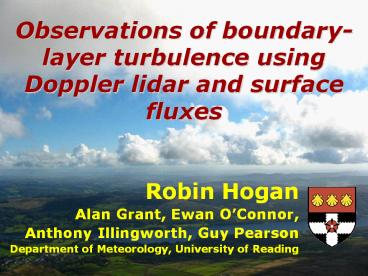Robin Hogan PowerPoint PPT Presentation
Title: Robin Hogan
1
Observations of boundary-layer turbulence using
Doppler lidar and surface fluxes
- Robin Hogan
- Alan Grant, Ewan OConnor,
- Anthony Illingworth, Guy Pearson
- Department of Meteorology, University of Reading
2
Overview
- Boundary-layer observations at Chilbolton
- Boundary-layer height mapping (Cyril Morcrette)
- Humidity convergence from refractivity (John
Nicol) - Evaluation of boundary-layer cloud forecasts
(Andrew Barrett) - Boundary-layer cloud microphysics (Ewan OConnor)
- Properties of turbulence from Doppler lidar and
surface fluxes - Variance and skewness of vertical wind
- The nature of turbulence driven by cloud-top
radiative cooling - Potential for evaluating boundary layer
parameterizations
3
Mapping BL top with radar
Radar BL top
Radar sees clear-air scattering from refractive
index inhomogeneities at boundary-layer top
Mesoscale model BL top
- Cyril Morcrette, MWR 2007
4
Refractivity
- Low-level atmospheric refractivity can be derived
by measuring the phase shift between pieces of
ground clutter with a scanning radar (higher
refractivity usually means higher humidity)
- Animation of refractivity during the passage of a
sea breeze from south - Met Office working to assimilate it to provide
information on humidity convergence as a
precursor to convection - John Nicol
5
Diurnal cycle composite of clouds
Radar and lidar provide cloud boundaries and
cloud properties above the site
- Andrew Barrett, submitted to GRL
6
Fluxes on 11 July 2007
7
(No Transcript)
8
Comparing variance to previous studies
- Lidar temporal resolution of 30 s
- Smallest eddies not detected, so add them using
-5/3 law - Only valid in convective boundary layers where
part of the inertial subrange is detected - Normalize variance by convective velocity scale
- Reasonable agreement with Sorbjan (1980) and
Lenschow et al. (1989)
9
Skewness
- Skewness defined as
- Positive in convective daytime boundary layers
- Agrees with aircraft observations of LeMone
(1990) when plotted versus the fraction of
distance into the boundary layer - Useful for diagnosing source of turbulence
10
Skewness in convective BLs
- Both model simulations and laboratory
visualisation show convective boundary layers
heated from below to have narrow, intense
updrafts and weak, broad downdrafts, i.e.
positive skewness
Narrow fast updrafts
Wide slow downdrafts
Courtesy Peter Sullivan NCAR
11
(No Transcript)
12
Why is skewness positive?
- Consider TKE budget
- Vertical flux of TKE is
- So skewness positive when TKE transported upwards
by turbulence
Stull
13
...a alternative related explanation
Large eddies only
- Updraft regions of large eddies have more intense
small-scale turbulence than the downdraft regions - This leads to an asymmetric velocity distribution
- Will test this later...
All eddies
14
11 April 2007
Stratocumulus cloud
15
Cospectrum
Vertical wind from 11 April 2007 at time of
transition
- The cospectrum, Cww2
- Defined as the complex conjugate of FFT of w
multiplied by FFT of w 2 - Can be thought of as a spectral decomposition of
the third moment - Hunt et al. (1988) showed that it goes as freq-2
in intertial subrange
16
Closed-cell stratocu.
- Previous studies have shown updraft/downdraft
asymmetry in stratocumulus at the largest scales - Puzzle as to why aspect ratio of cells is as much
as 301 - Shao Randall (JAS 1996)
17
Comparison of top-down and bottom-up
- Variance of vertical wind
- Good agreement with previous studies if H 30 W
m-2 - Variance peaks in upper third of BL agrees with
Lenschow et al.s fit provided theirs is inverted
in height
- Skewness
- Very good agreement with the fit of LeMone (1990)
to aircraft data provided hers is inverted in
sign and height
18
Aircraft vs LES
LES Moeng and Wyngaard (1988)
Aircraft observations LeMone (1990)
19
Upside-down Carsons model
- If all the physics is the same but inverted, we
can apply Carsons model to predict the growth of
the cloud-top-cooling driven mixed layer - With longwave cooling rate of H 30 W m-2 and
lapse rate of g 1 K km-1, we estimate growth of
1.1 km in 3 hours, approximately the same as
observed
20
Potential to evaluate the Lock BL scheme
Very little turbulence
Turbulence not reaching ground
Negative skewness
Lidar sees continuous cloud
Turbulence throughout BL
Skewness changes sign
Lidar sees continuous cloud
21
Potential to evaluate the Lock BL scheme
Turbulence with a minimum
Skewness changes sign
Lidar sees continuous cloud
Turbulence with a minimum?
Skewness of both signs
Lidar sees Cu below Sc
Turbulence below Cu base
Negative skewness
Lidar sees Cu
22
Conclusions
- Many ways in which the Chilbolton instruments can
be used to investigate the properties of the
boundary layer - Variance and skewness from 2.5 years of
continuous Doppler lidar data could be used to
evaluate the categories predicted by the Lock
boundary-layer scheme in the Met Office model - More details here
23
(No Transcript)
24
(No Transcript)

